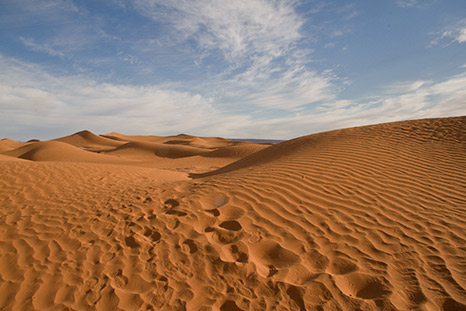
|

 |
Sahara Weather
The Sahara has one of the harshest climates in the world. Extreme dryness, high daytime temperatures and gale force winds are some of the desert's characteristics. Located in the trade winds belt, the region is subject to strong winds that blow constantly from the northeast between a subtropical high-pressure cell and an equatorial low-pressure cell. As air moves downward from the high-pressure into the low-pressure cell it picks up speed and as the fast moving air warms, it absorbs any available moisture. Under these conditions Sahara winds are powerful and precipitation is rare making the region one of the driest, windiest places on earth.
Except in a few of the higher mountainous areas, the average annual rainfall is less than 5 inches (130 mm). Most areas receive less than 2 inches. Some areas may have no rain for several years and then receive four or five inches in one brief torrential downpour.
Daytime temperatures, especially in summer, are among the world's hottest. Highs of more than 100° F. (38° C.) are common. Azizia, Libya, holds the world record high temperature of 136.4° F. (58° C.). Because the air is so dry and there are very few clouds the daytime heat rises and escapes allowing the temperature to quickly drop after sunset. Differences of as much as 50° F. (28° C.) between day and night temperatures are common, and overnight freezes can occur during winter.
Read more: Sahara Climate :: Wikipedia
Physical Geography
Considered as a whole, the Sahara is a rather low plateau with an uplifted center that has several mountainous areas. Elevations over much of the Sahara average only 1,000 to 1,500 feet (300 to 450 m) above sea level; in the central mountains a few peaks reach 10,000 to 11,000 feet (3,000 to 3,350 m). Except for the Nile and the Niger, which flow along the desert's far edges, there are no permanent rivers. There are numerous wadis, desert watercourses that contain water for only a short time after heavy rains. The most familiar of the Sahara's features is the erg, an area of dunes and drifting sand. Although widely distributed, ergs occupy scarcely more than a tenth of the Sahara's total area. Less well known than ergs, but covering much more of the surface, are regs, stony plains from which all sand and other fine materials have been removed by the wind. Large areas of exposed bedrock that have been worn smooth by the wind are known as hammadas.

It's as big as the United States and it's all covered with sand!
|
| |
|

